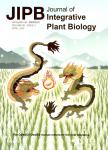Self-processing of ribozyme-flanked RNAs into guide RNAs in vitro and in vivo for CRISPR-mediated genome editing
Self-processing of ribozyme-flanked RNAs into guide RNAs in vitro and in vivo for CRISPR-mediated genome editing作者机构:Section of Cell and Developmental BiologyUniversity of California San Diego9500 Gilman DriveLa Jolla CA 92093-0116 USA
出 版 物:《Journal of Integrative Plant Biology》 (植物学报(英文版))
年 卷 期:2014年第56卷第4期
页 面:343-349页
核心收录:
学科分类:0710[理学-生物学] 07[理学] 08[工学] 09[农学] 071007[理学-遗传学] 0901[农学-作物学] 0703[理学-化学] 0902[农学-园艺学] 0836[工学-生物工程] 090102[农学-作物遗传育种]
基 金:supported by NIH R01GM068631 to Y.Z
主 题:CAS9 CRISPR DNA digestion gRNA genome genomeediting in vitro transcription ribozyme
摘 要:CRISPR/Cas9 uses a guide RNA (gRNA) molecule to execute sequence-specific DNA cleavage and it has been widely used for genome editing in many organisms. Modifications at either end of the gRNAs often render Cas9/gRNA inactive. So far, production of gRNA in vivo has only been achieved by using the U6 and U3 snRNA promoters. However, the U6 and U3 promoters have major limitations such as a lack of cell specificity and unsuitability for in vitro transcription. Here, we present a versatile method for efficiently producing gRNAs both in vitro and in vivo. We design an artificial gene named RGR that, once transcribed, generates an RNA molecule with ribozyme sequences at both ends of the designed gRNA. We show that the primary transcripts of RGR undergo self-catalyzed cleavage to generate the desired gRNA, which can efficiently guide sequence-specific cleavage of DNA targets both in vitro and in yeast. RGR can be transcribed from any promoters and thus allows for cell- and tissue-specific genome editing if appropriate promoters are chosen. Detecting mutations generated by CRISPR is often achieved by enzyme digestions, which are not very compatible with high-throughput analysis. Our system allows for the use of universal primers to produce any gRNAs in vitro, which can then be used with Cas9 protein to detect mutations caused by the gRNAs/CRISPR. In conclusion, we provide a versatile method for generating targeted mutations in specific cells and tissues, and for efficiently detecting the mutations generated.



